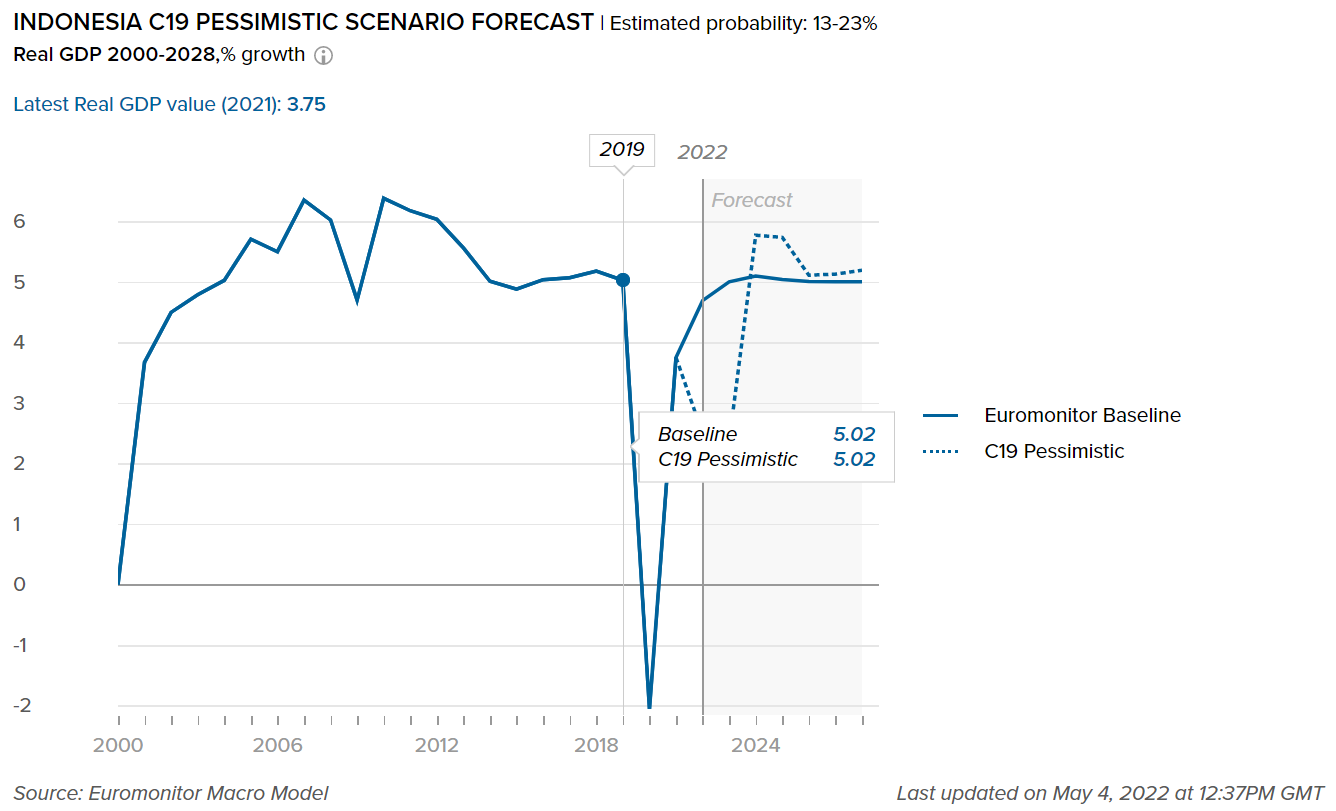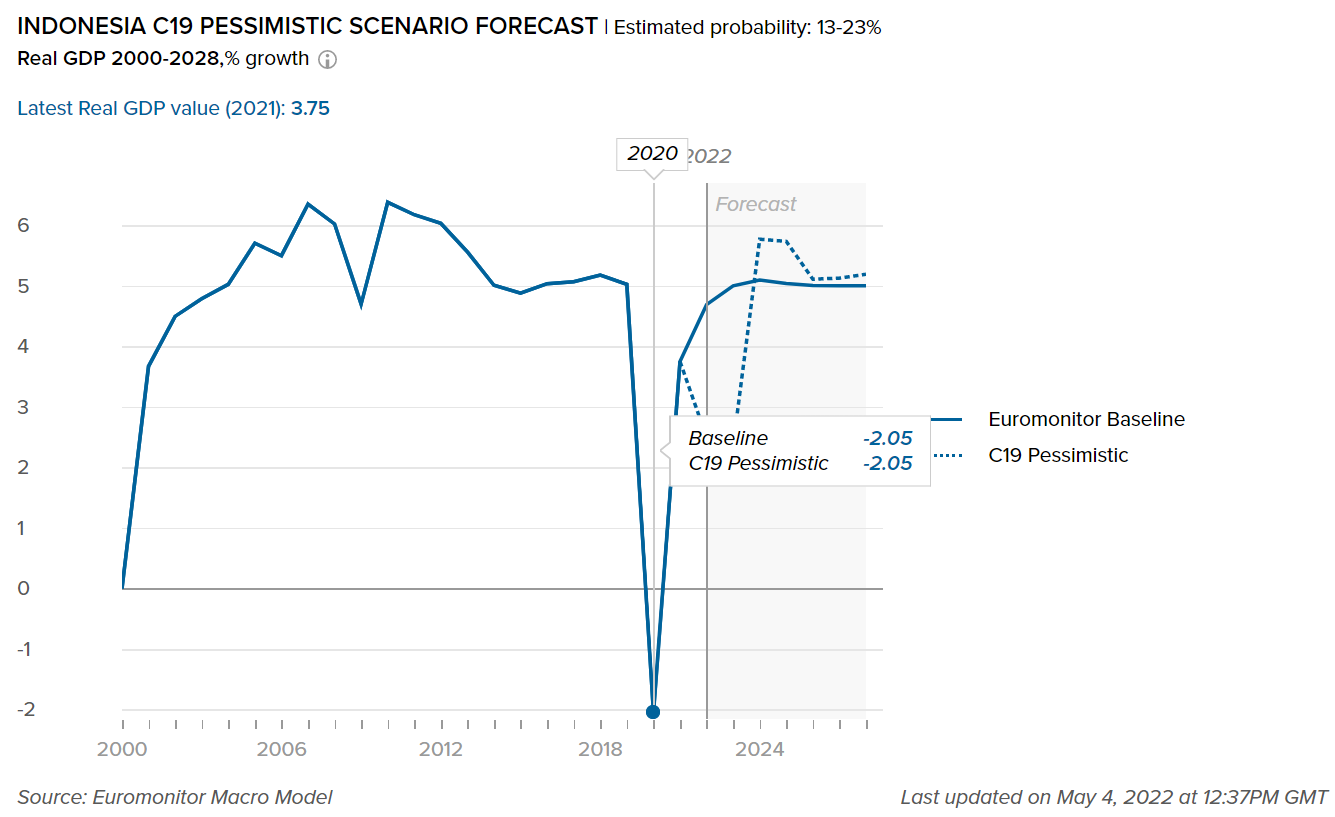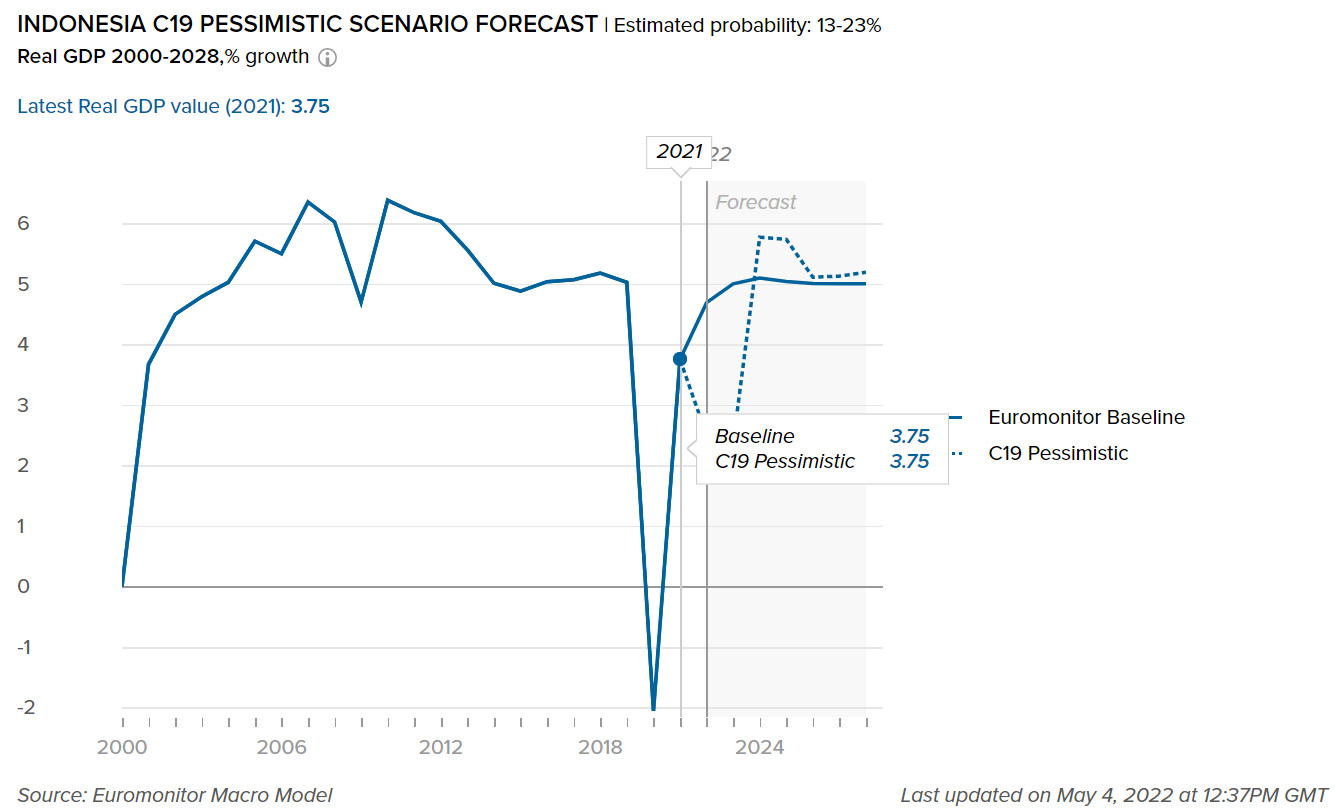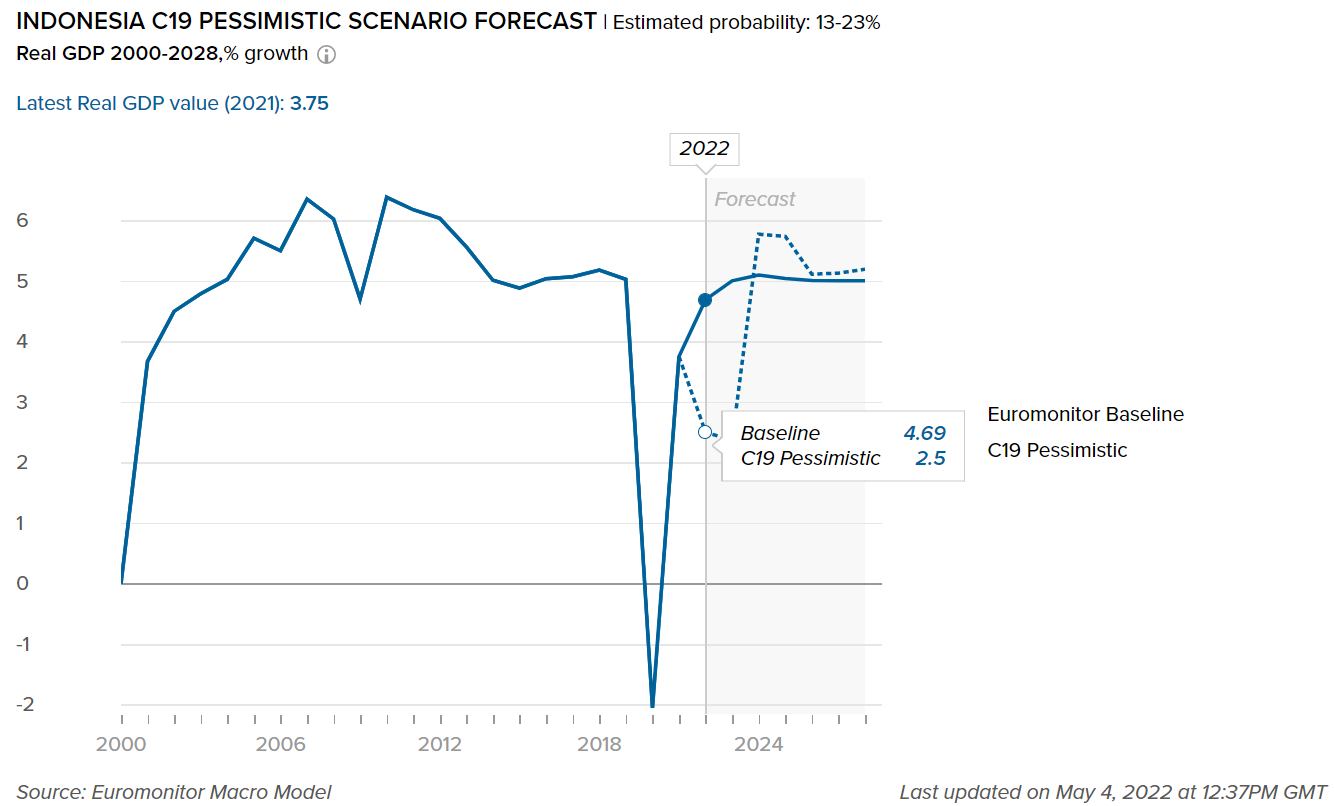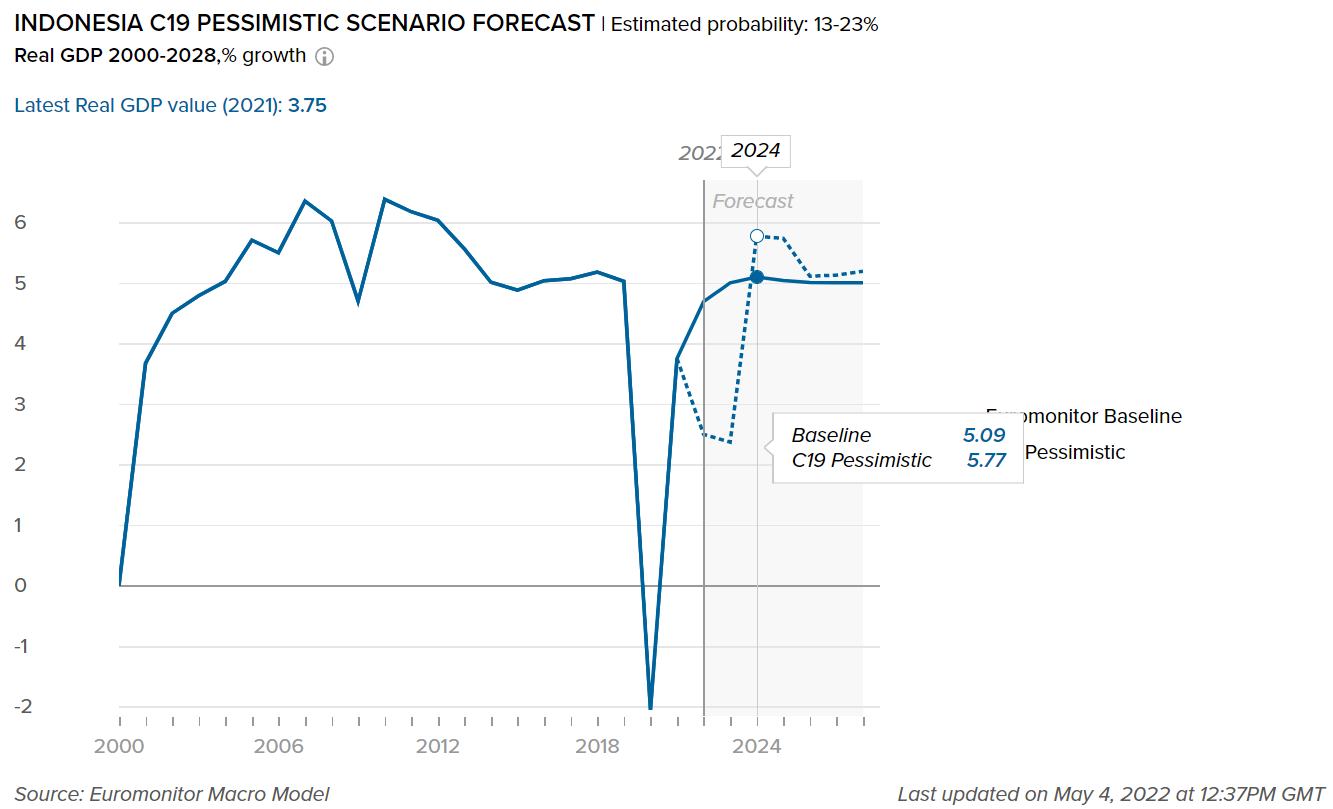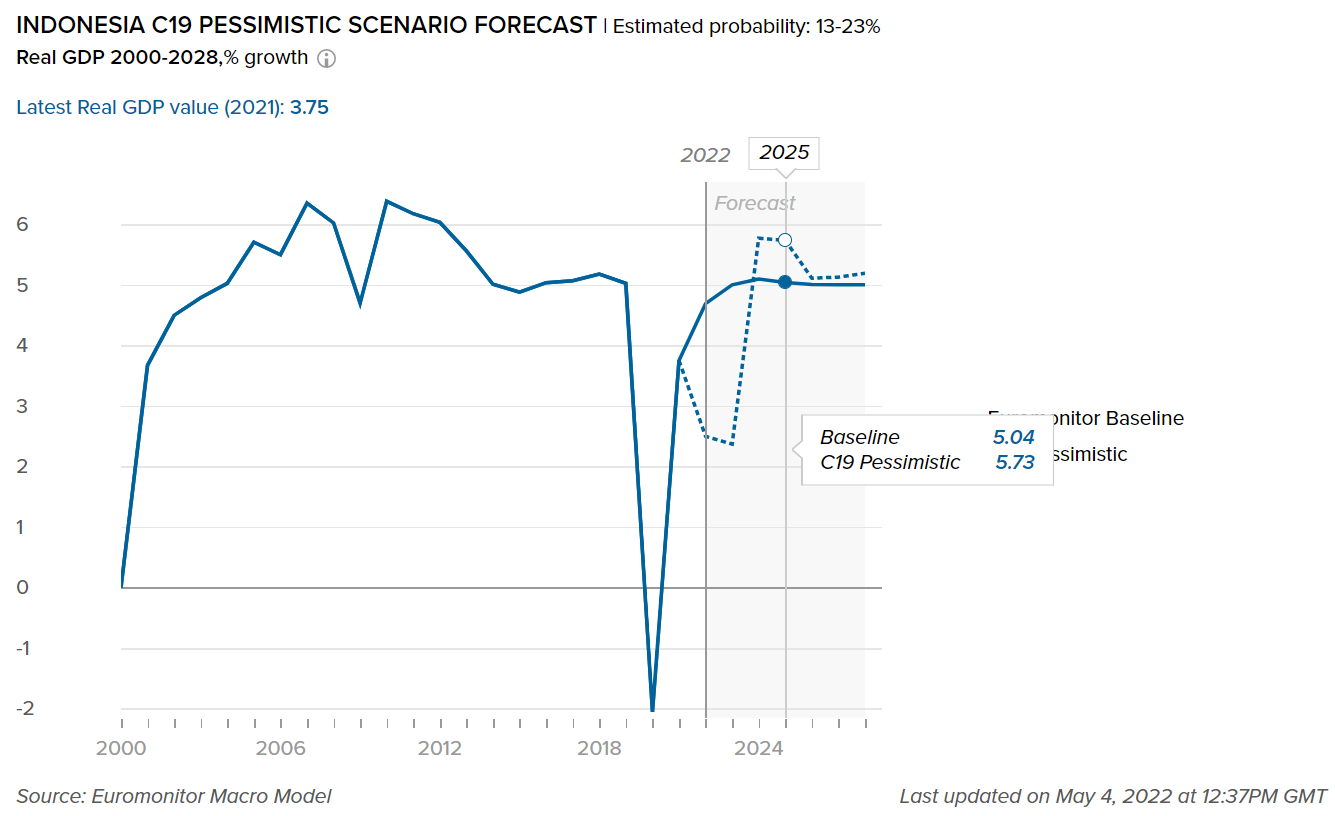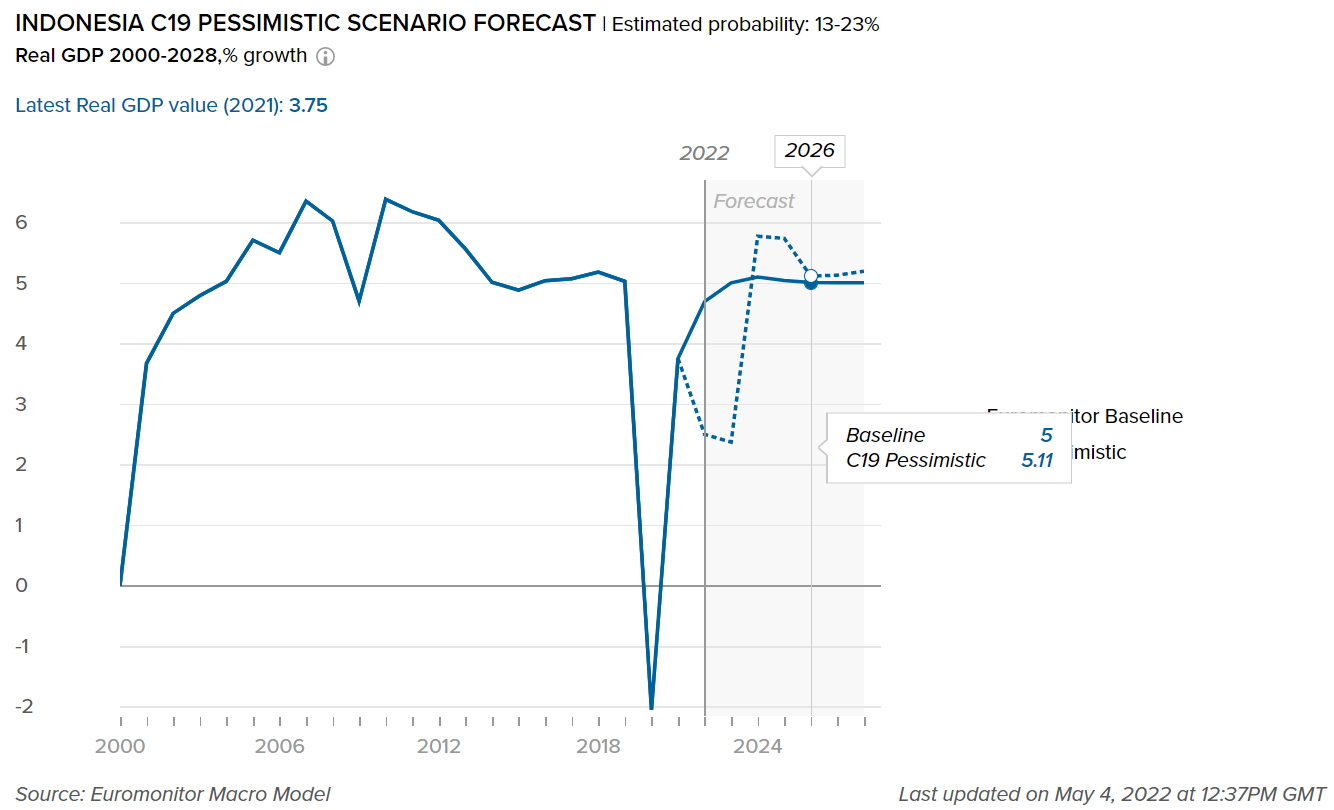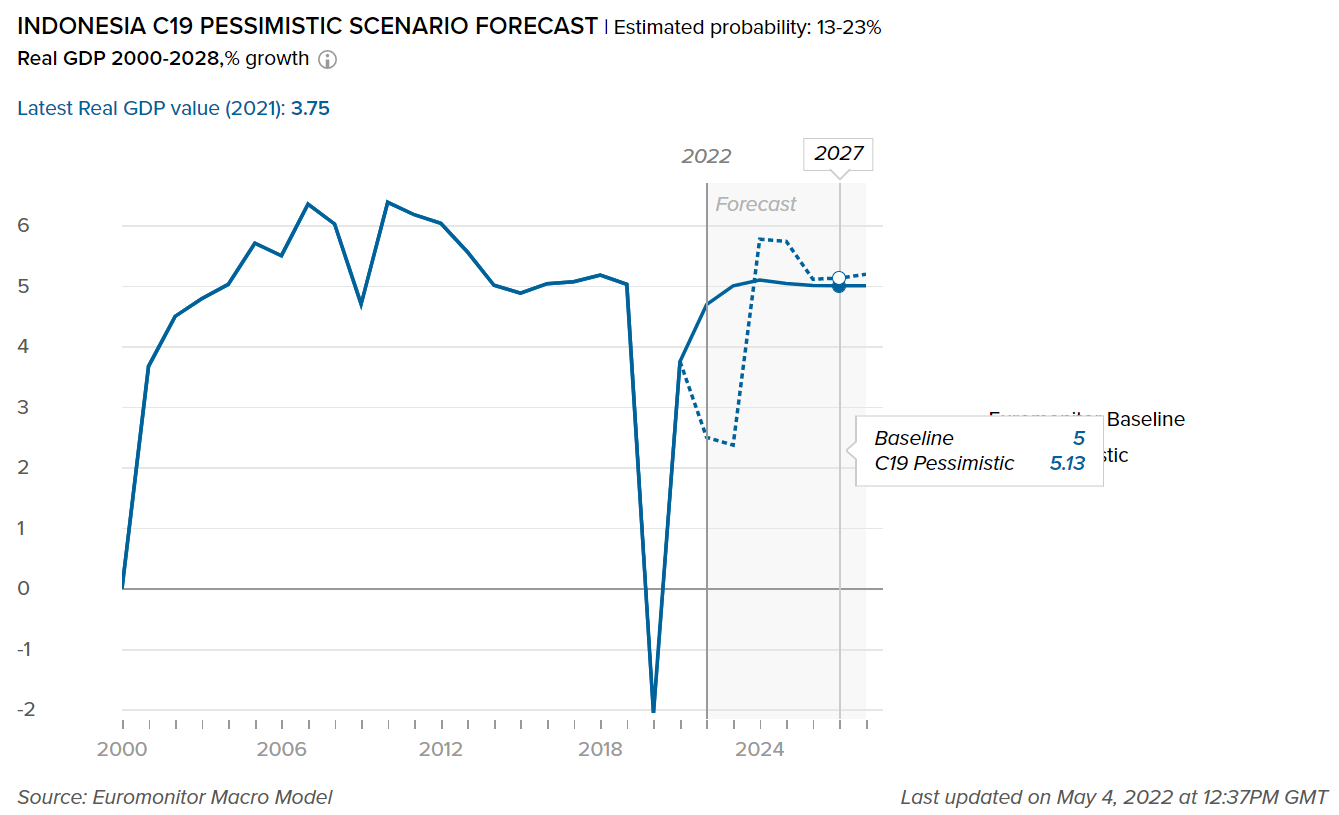Overview
- Packaging Overview
-
2020 Total Packaging Market Size (million units):
151,196
2015-20 Total Packaging Historic CAGR:
3.3%
2021-25 Total Packaging Forecast CAGR:
3.2%
Packaging Industry
2020 Market Size (million units)
Beverages Packaging
70,971
Food Packaging
68,038
Beauty and Personal Care Packaging
7,837
Dog and Cat Food Packaging
52
Home Care Packaging
4,298
Packaging Type
2020 Market Size (million units)
Rigid Plastic
48,289
Flexible Packaging
82,810
Metal
4,086
Paper-based Containers
8,449
Glass
2,031
Liquid Cartons
4,951
- Key Trends
-
Brands in soft drinks and hot drinks are pushing smaller pack sizes to consumers with less disposable incomes. As smaller packs are mostly made of flexible plastic, it is set to gain from this trend. Flexible plastic remained a primary type of packaging material in home care in Indonesia, as it is a more affordable option, and is versatile in terms of format and size. Multipacks witnessed rising demand as at-home consumption increased due to home seclusion, andbrands promoted multipacks by placing them at a prominent location in hypermarkets/supermarkets.
Travel-size packaging formats in beauty and personal care appeal through convenience and low cost. Consumers with limited disposable incomes usually opt for products with lower selling prices, such as smaller packs. On the other hand, in modern retail outlets, consumers tend to purchase refill pouches because they already have the PET packaging format at home, with the pouches offering convenience and value for money as they will be used for refilling the at-home PET packaging.
- Packaging Legislation
-
In October 2015, the Ministry of Trade implemented new legislation that mandates all manufacturers, importers, wholesalers, and retailers must use Bahasa Indonesia for the labeling of all their products. This labeling regulation helped to eliminate the language barrier and allows consumers to fully understand all product information displayed on the packaging. Over the long term, however, labeling requirements are likely to prove beneficial for imported brands as the use of Bahasa Indonesia labeling will help them engage and communicate better with local consumers. In addition, the legislation also requires each company to include its full address on the packaging of all products. This applies to all consumer goods sold in Indonesia.
- Recycling and the Environment
-
The Ministry of Environment and Forestry (KLHK) set a 2025 target to reduce waste by 30%. The government’s plan to impose a tax on plastic will include the classification of excisable goods in a move that was originally meant to cover only single-use plastic bags. The starting point of a tariff on plastic bags has been chosen to ease the country into the new situation gently, given that many rules and regulations have already been imposed in recent times. Food and beverage packaging plastics will also be subject to the new excise tax. Most major grocery retailers in Indonesia now offer eco-friendly plastic bags which will degrade in less than two years and are made from materials such as oxium plastic.
- Packaging Design and Labelling
-
In September 2019, under the National Agency of Drug and Food Control’s Regulation no. 22/2019, all processed food and beverages must carry information of the product’s salt, sugar, and fat content on the packaging. The new labeling system is a color-coded system wherein a red color warns of high levels of certain ingredients. The healthier choice logo allows for quick comparison of a product with others in terms of nutritional benefit and aims to encourage consumers to read the labels more closely on products they purchase. The new halal logo launched in October 2019 and known as Halal Indonesia will be mandatory by October 2022, with business and services permitted a three-year grace period to use the old halal logo before making the change.
Click here for further detailed macroeconomic analysis from Euromonitor
- Definitions
-
- Beauty and Personal Care Packaging: This is the aggregation of packaging for baby care, bath & shower products, deodorants, hair care, color cosmetics, men's grooming products, oral hygiene, perfumes & fragrances, skincare, depilatories, and sun care. Black market sales and travel retail are excluded.
- Dog and Cat Food Packaging: This is the aggregation of dog and cat food packaging.
- Packaged Food Packaging: This is the aggregation of packaging for baby food, Bakery, canned/preserved beans, canned/preserved fish/seafood, canned/preserved fruit, canned/preserved meat and meat products, canned/preserved tomatoes, canned/preserved vegetables, other canned/preserved food, confectionery, chilled fish/seafood, chilled lunch kit, chilled processed meats, fresh cut fruits, dairy, dessert mixes, rice, frozen bakery, frozen desserts, frozen meat substitutes, frozen processed fish/seafood, frozen processed potatoes, frozen processed poultry, frozen processed red meat, frozen processed vegetables, other frozen processed food, ice cream, meal replacement, noodles, oils and fats, pasta, ready meals, sauces, dressings and condiments, snack bars, soup, spreads and sweet and savory snacks.
- Home Care Packaging: This is the aggregation of packaging for laundry care, dishwashing products, surface care, chlorine bleach, toilet care, polishes, air fresheners, and insecticides.
- Beverages Packaging: Beverage packaging is the aggregation of alcoholic drinks packaging, hot drinks packaging, and soft drinks packaging.
Beverages
- Overview
-
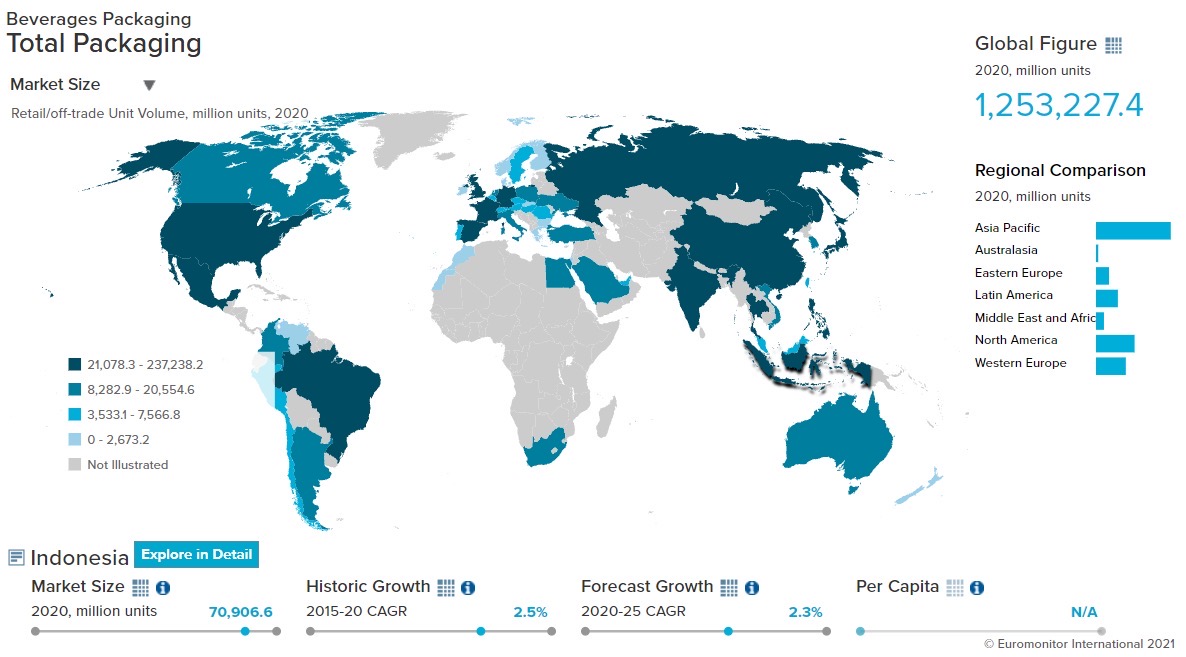
- Flexible Packaging Landscape
-
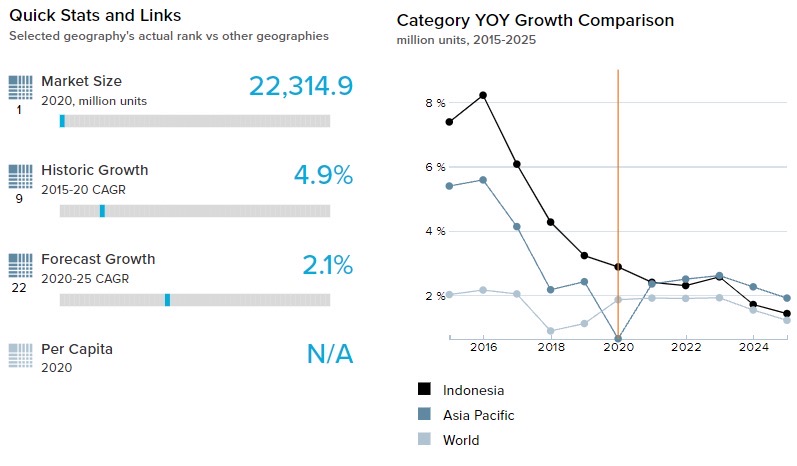
- Due to the presence of COVID-19, consumers were looking for medium-sized or large pack sizes of hot drinks to stockpile at home. Consumers feared retailers running out of stock and wanted to reduce the frequency of visits to physical stores to minimize exposure to the virus. Popular pack types like flexible aluminum/plastic, therefore, saw a rise in sales, helping flexible packaging grow by 3.4% by volume in hot drinks packaging in 2020.
- As outdoor movement was restricted due to measures implemented to contain the spread of COVID-19, this meant the loss of on-the-go consumption of soft drinks. This affected single-serve pack types of soft drinks such as flexible plastic containers. However, these restrictions increased at-home consumption, resulting in more sales of larger pack sizes in folding cartons. Flexible packaging lost ground to folding cartons as they are used more often in the packaging of large packs. As a result, flexible packaging declined by 8.1% by volume in soft drinks packaging in 2020.
- Trends
-
- Multipacks are becoming more prominent in beer as at-home consumption increases. The closure of foodservice/restaurants boosted the at-home consumption of beer. Consumers preferred multipacks to avoid multiple visits to the store, which manufacturers heavily promoted. Multipacks of metal beverage cans are placedin more prominent locations in off-trade channels, such as individual islands, in supermarkets or hypermarkets. As a result, metal beverage cans witnessed 12.2% growth by volume in 2020.
- Folding cartons and flexible packaging are growing as consumers are becoming more health-conscious against the backdrop of the COVID-19 pandemic. This is driving sales in categories such as green tea, which is predominantly packaged in folding cartons. Single-serve packs in flexible packaging are gaining popularity within coffee as they are convenient for immediate consumption and are relatively affordable. Flexible packaging is also being used for refill options for rigid containers, particularly among consumers on restricted budgets.
- Outlook
-
- Fresh ground coffee pods are expected to continue growing over 2021-25. As the economy is likely to return to normal in the post-pandemic period, consumption in terms of single-serve packs and smaller sizes is expected to pick up. This is likely to boost sales of popular pack types such as flexible aluminum/plastic for fresh and instant coffee and folding cartons for tea in the coming years. It is estimated that flexible plastic and folding cartons will grow at 2.2% and 1.9% by volume respectively over 2021-25.
- Bottled water is expected to record healthy annual growth rates over 2021-25 as consumers are using water to stay hydrated and avoiding certain other categories such as energy drinks, carbonates, and juices that have high sugar content because of health concerns. This is driving the usage of 330ml and 600ml PET bottles, although 1,500ml is also an important pack size. On the other hand, glass bottles are expected to decline in still bottled water due to their fragile nature. As consumers are becoming more health-conscious, they prefer reduced-sugar drinks or limited portions for consumption. As a result, sugary drinks are expected to be in lower demand, although smaller pack sizes of them are expected to become more popular.
Click here for more detailed information from Euromonitor on the Beverages Packaging industry
Dog and Cat Food
- Overview
-
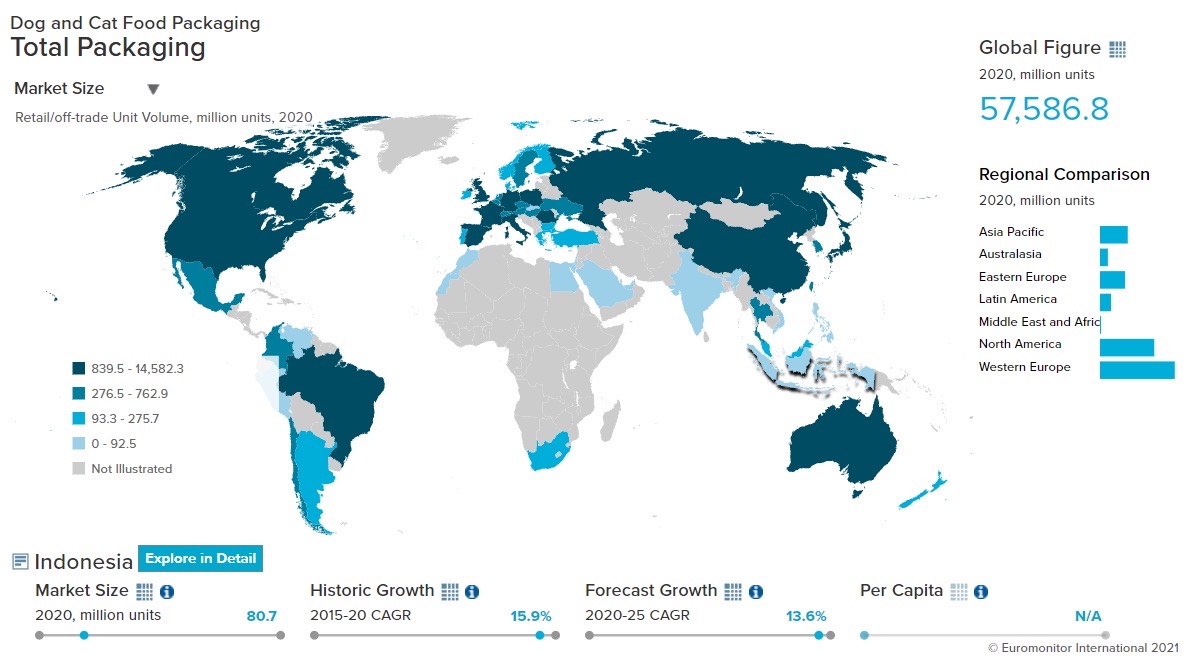
- Flexible Packaging Landscape
-
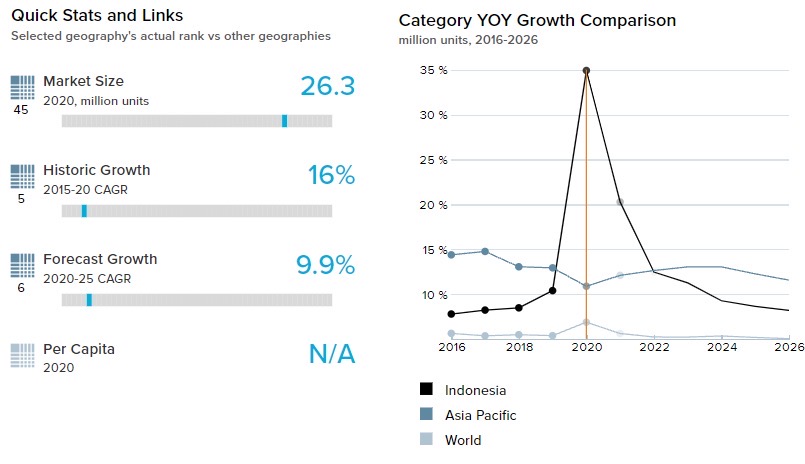
- Consumers are switching from metal food cans to aluminum/plastic pouches or aluminum trays, which provides a greater degree of convenience and freshness to consumers. Normally, pouches and aluminum trays for wet dog and cat food contain only single-serve portions, that eliminates the need for consumers to store leftover products. But popular brands such as Pedigree (Mars Foods Indonesia) and Royal Canin (Royal Canin Indonesia) now offer large packs of wet food variants in flexible packaging. As a result, flexible packaging grew by 6.3% by volume in dog and cat food packaging in 2020.
- Flexible packaging is the most common pack type for dry dog and cat food, as it is the most suitable packaging material for ensuring airtight storage to prevent oxidation or spoilage. Manufacturers are launching new flexible packs with zip/press closures that will help consumers to maintain the freshness of food. As a result, flexible packaging grew at 22.3% and 8.4% by volume in dog and cat food respectively.
- Trends
-
- With dog and cat food products increasingly seen in stand-up pouches, this is also benefiting zip/press closures. The convenience, practicality, and no-mess features of zip/press closures are popular among local consumers, even if they generally carry a higher price tag. Thus, zip/press closures are mainly found in premium dog and cat food, while also having some presence in value-added mid-priced products. Leading premium brands such as Hill’s Science Diet and Royal Canin also use zip/press closures on their dry dog food, while pet treats and wet food players are also beginning to use zip/press closures for some of their products.
- Small pack sizes continue to gain in popularity in Indonesia, supported by the expansion of convenience stores, supermarkets, and hypermarkets with lower retail selling prices and by consumers’ growing demand. Many are attracted to smaller packs by their lower pack price and ease of carrying, with these factors also encouraging impulse purchases. Apart from that, the rise in health-consciousness is set to have an impact across product categories, leading to demand for food with a healthier image such as nutritional supplements. During the pandemic, pet owners spent more time with their pets, thus the pet humanization trend is expected to influence the market. Humanization is likely to support the health-consciousness trend.
- Outlook
-
- Dog and cat food packaging is expected to continue growing in line with the increasing pet population in the country, driven by the rapid rate of urbanization and expanding middle-income consumer segment. This is likely to include larger pack sizes benefiting from increasing numbers of larger dog breeds. On the other hand, smaller pack sizes are expected to grow as companies are likely to launch smaller packs of premium products. While it is common for economy products to sell in pack sizes up to 20kg, premium brands are more commonly sold in packs up to 7kg. Metal food cans, followed by flexible plastic, are expected to remain the main pack types for dog and cat food over 2021-25.
- Rising health awareness among affluent dog owners is expected to cause a shift towards raw dog food, which is deemed to be healthier than packaged dog food. These products can be purchased, prepared, and made from high-quality fresh produce. However, raw food diets cost far more than most packaged dog food products. Thus, raw dog food is likely to be packaged in premium packaging such as stand-up pouches. The boost in the raw dog food category is expected to help stand-up pouches grow over 2021-25.
Click here for more detailed information from Euromonitor on the Dog and Cat food Packaging industry
Beauty and Personal Care
- Overview
-
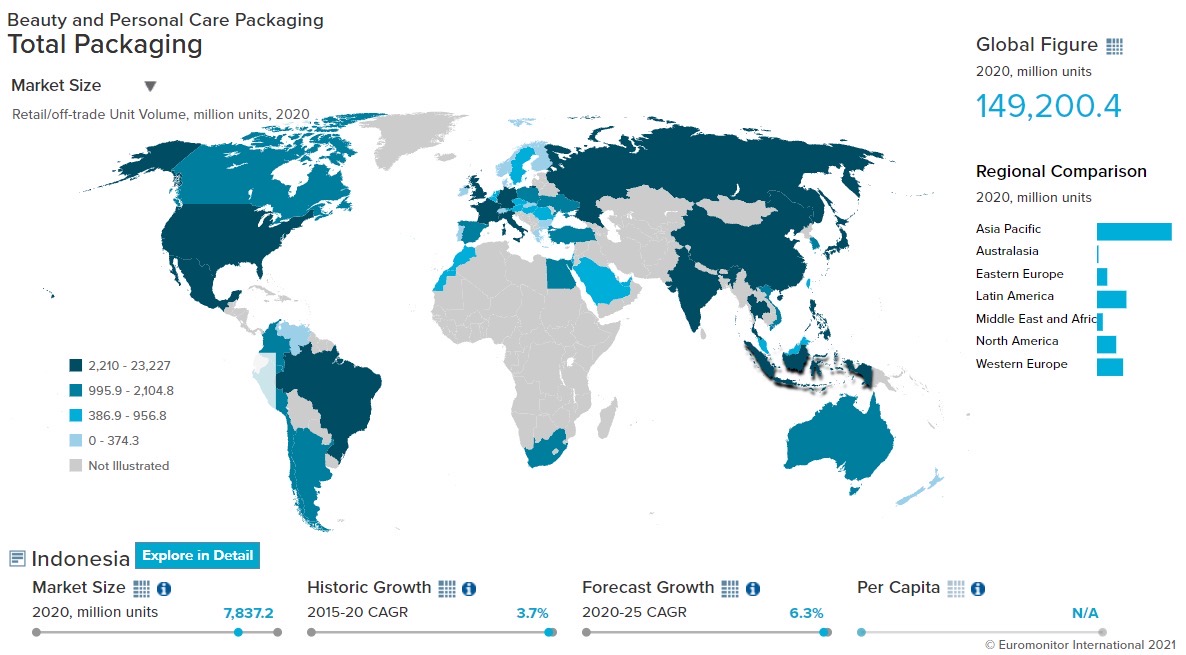
- Flexible Packaging Landscape
-
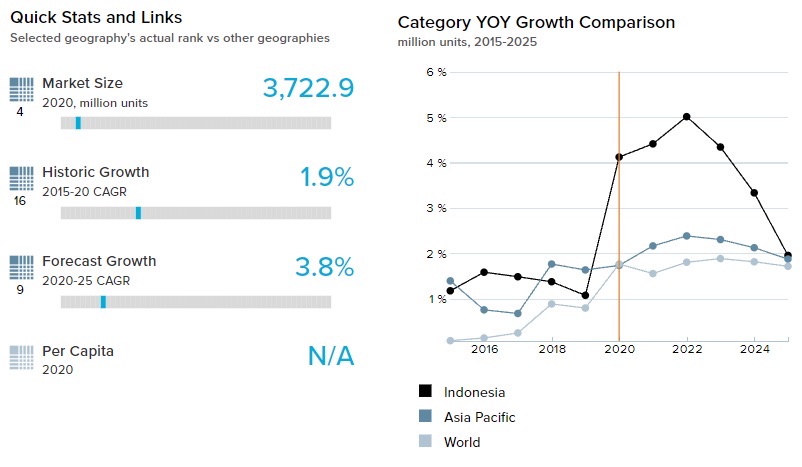
- Due to COVID-19, increased awareness of hygiene caused higher demand for bath and personal care products. Also, due to the fear of the spread of the virus, people stockpiled personal care products such as liquid soap, sanitizers, hand wash, bar soaps, etc. As a result, larger packs made of flexible plastic and stand-up pouches shampoo, hair care, liquid soap, hand wash, etc. witnessed strong growth of 27.7% by volume in 2020.
- In color cosmetics packaging, flexible packaging witnessed a strong decline of 4.2% by volume in 2020 due to the lockdown measures implemented that prohibited people from attending social gatherings or going out for work. On the other hand, due to salon closures and the increased numbers of consumers painting their nails at home, small glass bottles with nail polish and polish remover recorded positive growth in color cosmetics packaging.
- Trends
-
- Indonesia, which is the second-largest ocean plastic polluter in the world, has seen several environmentally friendly start-ups in recent years aiming to cut back on plastic waste. Siklus, a start-up that helps fight rising plastic waste, allows consumers to refill personal and home care essentials such as soap, dishwashing liquid, and detergent at home through the company’s app. The products are unpackaged and customers need to carry their original packs to refill the product.
- Smaller sizes in color cosmetics gained popularity as it allows consumers to carry products with them when they are out, with women seeking out small packaging formats that will easily fit into their handbags. Some brands launched perfume in glass roll-on packaging formats, with each unit containing just a few milliliters of liquid perfume. The perfumes can be used on the go and consumers have responded positively to this small roll-on format.
- Outlook
-
- Small sachets of beauty and personal care products, such as mouthwash, body wash, hand soaps, etc., are expected to record growth over 2021-25 as consumers are expected to start traveling more often once vaccinated. Convenience, portability, and lower unit prices are some of the attributes that will aid the growth of smaller packs. For example, within eyeliners, attractively priced sachets such as Moko Moko are expected to see growth over 2021-25.
- Sustainable packaging and natural ingredients are becoming popular among Indonesian consumers and are expected to see growth over 2021-25. Brands that invest in innovative packaging and promote organic products at the same time are expected to gain popularity. Consumers with high disposable incomes are expected to pay more for sustainable packaging and organic products. Sustainability as a trend is expected to gain momentum over 2021-25.
Home Care
- Overview
-
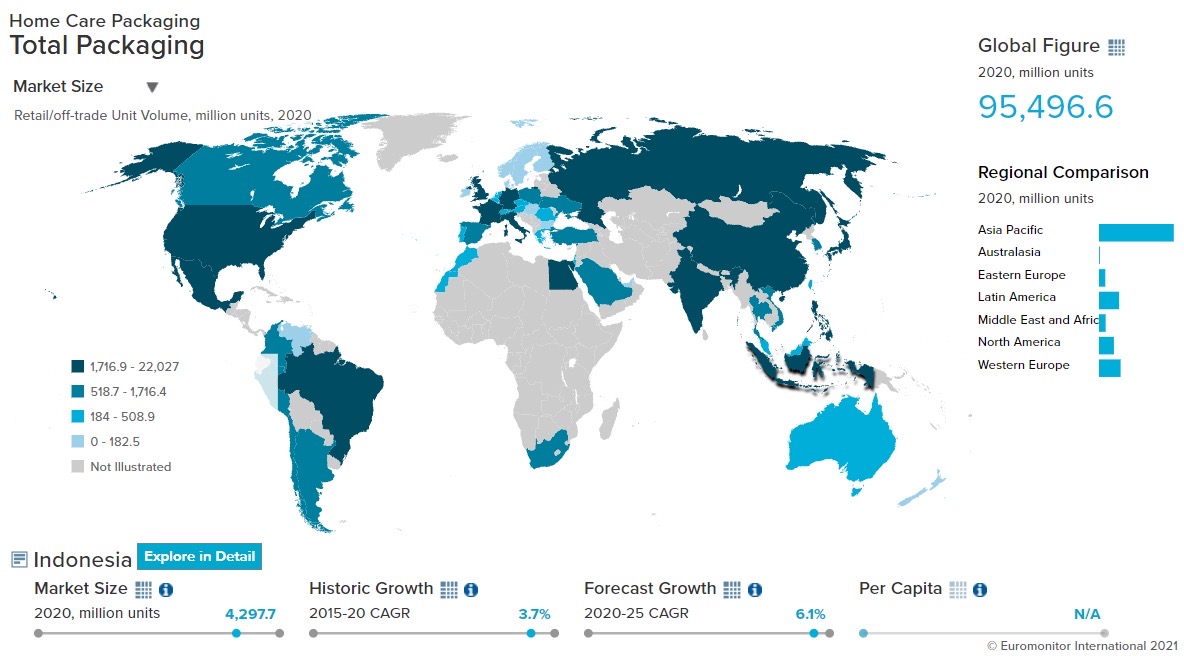
- Flexible Packaging Landscape
-
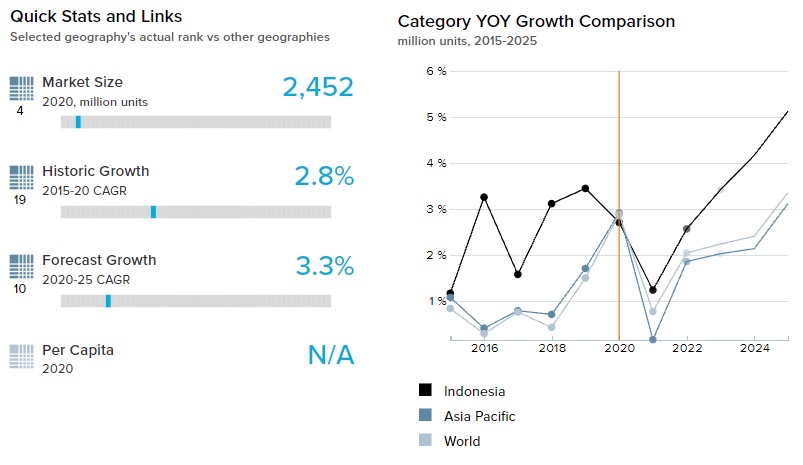
- Before the pandemic, manufacturers announced that the use of plastic for packaging would be completely eradicated. However, consumers became skeptical of reusable packaging during the pandemic due to the risk of contracting the virusus, manufacturers put their plans on hold and consequently returned to other formats of packaging such as plastic. As a result, flexible packaging grew 2.7% by volume in home care packaging in 2020.
- Flexible packaging gained traction during the pandemic. This can be attributed not only to being a more affordable option but also to its versatility in terms of packaging format and packaging size. Stand-up pouches gained popularity during the pandemic as they were offered with innovative formats such as zip/press closures. As a result, stand-up pouches grew 13.4% by volume in home care packaging in 2020.
- Trends
-
- The economic fallout of the pandemic led to the reduced disposable income of the population. Thus, affordability became a prime factor in purchasing decisions. Smaller packs were preferred by the consumers over larger packs due to the low upfront cost. Small packs such as sachets and pouches were trending, even if this made the product more expensive than a larger pack size in terms of price per liter/kg.
- Despite a travel ban in the initial months of the shutdown, there was a surge in demand for travel-sized sanitizers, which are usually packed in pouches. This can be attributed to low disposable income. Consumers and businesses were also buying sachets of sanitizers to further reduce the risk of contracting the virus by touching common surfaces. In addition, sales of pouches were also being supported by marketing that targets price-sensitive consumers. When considering the same product in different types of packaging, pouches usually offer greater value for money, thus helping them gain popularity.
- Outlook
-
- With the approval and implementation of several vaccines in 2021, consumers are gradually returning to their normal lives. Manufacturers are likely to return to scaling down their usage of single-use plastic and continue innovating with new and sustainable packaging formats for home care products. Metal packaging is expected to experience a challenging environment following the Indonesian government’s decision to extend the anti-dumping duties on steel and tinplate products from countries such as China and Vietnam into
Click here for more detailed information from Euromonitor on the Home Care Packaging industry
Packaged Food
- Overview
-
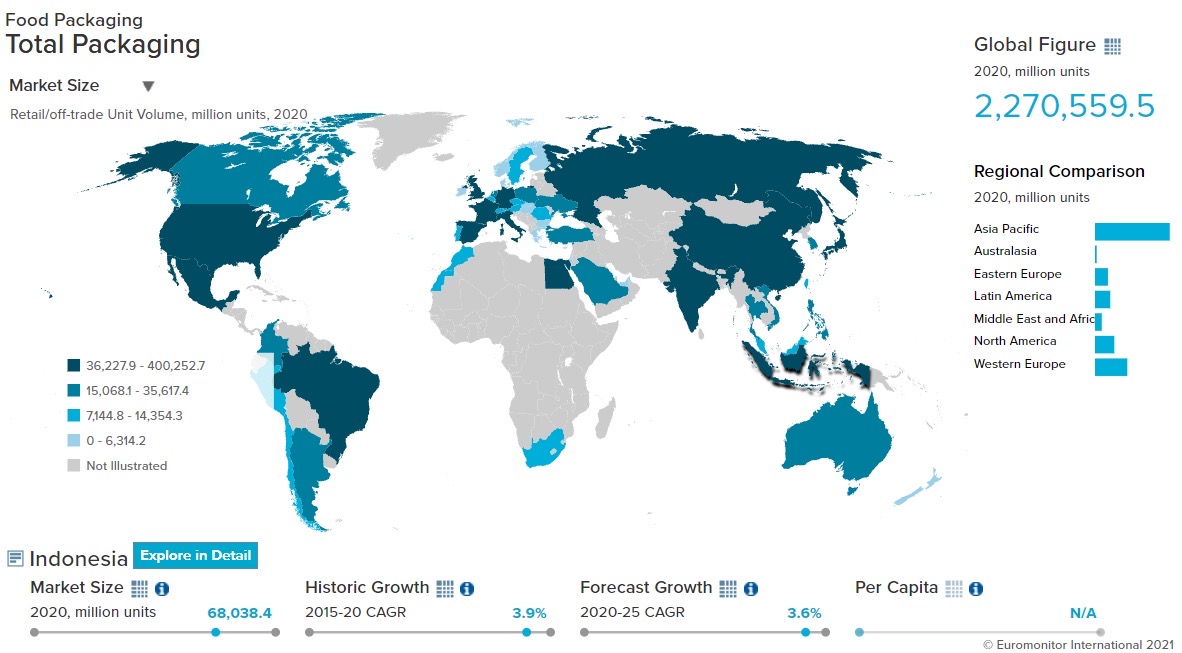
- Flexible Packaging Landscape
-

- Ready meals in Indonesia are mostly comprised of frozen processed meat and seafood. Flexible packaging is preferred by the manufacturer as it keeps the meals fresh, airtight, and protects from water exposure while in freezer storage. Products that come in flexible plastic are often found in a wider range of distribution channels, while those in folding cartons tend to target more specific consumer groups or offer only a certain type of cuisine. As a result, flexible packaging in ready meals grew by 3.1% in terms of volume in 2020.
- Despite the disruption of the COVID-19 pandemic, dairy brands in Indonesia continued to experiment with flexible packaging designs. In processed cheese, for instance, brands have introduced new shelf-stable cheese sticks sold in small 12g and 48g flexible plastic packs. These new products are convenient for on-the-go consumption, are shelf-stable, and available in a variety of flavors. A few players made multipacks out of these small packs, and it appealed to consumers in lockdown in 2020 as at-home consumption increased demand for easy, healthy snacking options. Innovations in processed cheese such as this helped to record 4.1% growth by volume of flexible plastic in dairy packaging in 2020.
- Trends
-
- The prepared baby food industry shifted from glass jars to stand-up pouches as they gained popularity among manufacturers as well as consumers. An existing example includes Milna’s recent launch of its Milna Nature Delight in 80g stand-up pouches. Stand-up pouches in prepared baby food are seen as having further potential, as more households have both parents working and are experiencing faster-paced lifestyles. Stand-up pouches offer a convenient on-the-go consumption solution and have hygienic closures for products that are not finished in one go, as most pouches are equipped with zip/press closures or plastic screw caps.
- Sugar confectionery was negatively impacted by the COVID-19 pandemic, as many products in this category are targeted at children. With fewer opportunities to leave the house, impulse purchases of sugary treats by parents for their children were much less common in 2020. Health and wellness trends also contributed to the drop in retail volume sales in sugar confectionery. As a result, flexible plastic folding cartons took a hit in confectionary packaging in 2020.
- Outlook
-
- Flexible plastic is expected to remain as the top pack type as manufacturers introduced stand-up pouches and flexible packs with zipping/press closures to maximize freshness. It is also expected to remain popular in confectionery packaging due to its wide range of applications across a variety of chocolate and sugar confectionery categories. This pack type is also appealing to manufacturers as it is effective to maintain lower product costs, ensuring that their products are more accessible to a wide consumer base. Zip/press closures are expected to perform well as they help to preserve product freshness in a climate that is hot and humid as well as being convenient for on-the-go consumption and giving a product a more premium image.
- Glass jars are expected to lose ground to more convenient and less breakable and economical alternative pack types such as flexible plastic and folding cartons in prepared baby food. Manufacturers are expected to position glass jars as a pack type that is associated with premium products, that are more expensive to produce and tend to bear a higher unit price. As glass jars are expected to be stagnant over 2021-25, stand-up pouches and thin wall plastic containers are projected to record faster growth, gaining a share in prepared baby food from less convenient glass jars.
Click here for more detailed information from Euromonitor on the Packaged Food Packaging industry
RECOVERY FROM COVID
- Overview of COVID-19 conditions in Indonesia
-

In comparison to other markets in the region, Indonesia records a lower number of cases per million inhabitants
- According to the World Health Organization (WHO), on May 2022, Indonesia had 6,053,670 COVID-19 cases, with 156,556 deaths and 246 new daily cases.
- According to the WHO, as of May 2022, Indonesia’s total cases per million inhabitants was 22,132. In comparison, the Philippines recorded 33,669 on the same day.
- As of May 24, 2022, Indonesia’s total administered vaccine doses stood at 411,503,064, representing 61.0 of 100 persons, based on the World Health Organization.
The chart below shows Euromonitor International’s Recovery Index.
The quarterly reported Recovery Index is a composite index that provides a quick overview of economic and consumer activity. It keeps track of the latest quarterly economic/consumer data and forecasts in key economies to gauge when economic activity and consumer demand are likely to return to the pre-pandemic levels of 2019.
A score of 100 and over indicates a full recovery in which economic output, the labor market, and consumer spending all return to/exceed 2019 levels.
Detailed methodology is provided in the Appendix.Quarterly Recovery Index and Related Indicators, Indonesia
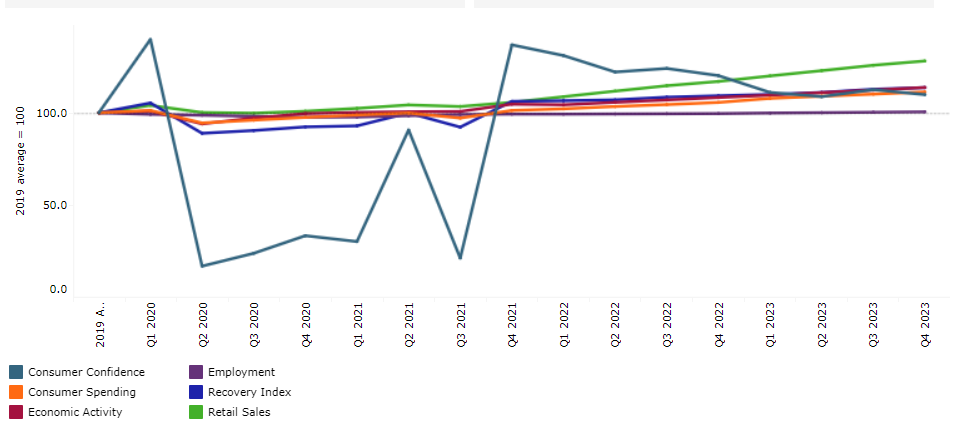
- Impact on GDP
-
This graph shows our “best case” and “worst case” estimate scenarios of how COVID-19 will impact the real GDP value in Indonesia. Our “best case” or Baseline scenario has an estimated probability of 65-75% over a one-year horizon. Our “worst case” or Pessimistic2 scenario has an estimated probability of 2-5% over a one-year horizon. For more details, please refer to the detailed explanation of the COVID-19 scenarios in the Scenario Definitions section.
Please note that the forecasts will be adjusted every three months, according to the expected number of cases, recoveries, and deaths due to COVID-19 in this country, as well as shifting socioeconomic conditions (the most recent update was January 2022).
Baseline forecast refers to the "best case" COVID-19 scenario forecast that has an estimated probability of 45-60%.
C19 Pessimistic refers to the "worst-case" COVID-19 scenario forecast that has an estimated probability of 13-23%.
Indonesia’s exports reached a record high in 2021, boosting further economic growth
- Indonesia's real GDP expanded by 3.7% in 2021, far behind Asia Pacific's average growth of 6.4%. Strong exports, solid industrial activity, and supportive macroeconomic policy measures drove the country's economic development this year. Household consumption and private investment on the other hand remained flat. Over the course of the year, the continued COVID-19 epidemic and re-imposed containment measures slowed the recovery of both the economy and the labor market. On this note, the unemployment rate has continued to rise, standing at 6.4%.
- In January 2022, the government implemented new tax reductions on property and car sales in order to stimulate economic recovery. The chances of additional infection waves, supply chain disruptions, and increased financial market volatility amid global monetary tightening, however, cast a shadow over the economy's prospects. The country's National Medium-Term Development Plan 2020-2024 intends to boost prosperity, develop infrastructure, increase human capital investment, and improve public services.
- After a fall in 2020, the strong recovery in global demand bolstered international merchandise trade, surpassed pre-pandemic levels internationally in 2021. Indonesia's export value increased by 40.5% to record high levels in 2021 due to growing global commodity prices. During the year, goods exports accounted for 19.5% of Indonesia's GDP, lower than the Asia Pacific average of 24.4%. Mineral products remained Indonesia's most valuable export category in 2021, accounting for 17.1% of the country's overall export value. With 27.3% of all products exported to China during the year, China remained Indonesia's most important trading partner.
- Impact to Sector Growth
-
Please note that the forecasts are adjusted every three months according to the expected number of cases, recoveries, and deaths due to COVID-19 in the country, as well as shifting socioeconomic conditions.
The graph below shows the adjusted forecasts of the percentage growth for the categories mentioned, highlighting the impact of COVID-19 between our pre-COVID-19 estimates and the “most probable” (Baseline) forecast, which has an estimated probability of 45-60%.
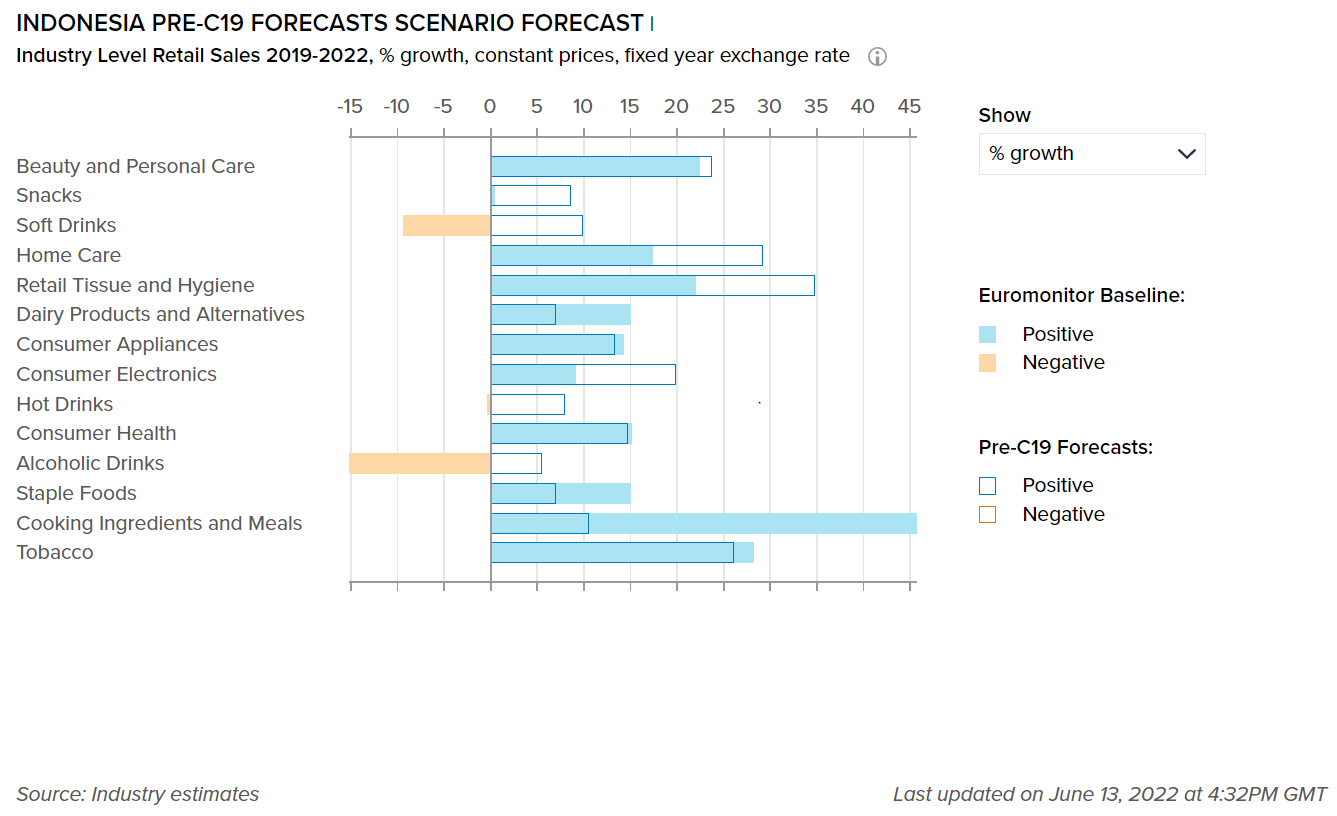
Baseline forecast refers to the "best case" COVID-19 scenario forecast that has an estimated probability of 45-60%.
The rather sombre national mood that emerged during the pandemic continues to impact demand for alcoholic drinks
- The COVID-19 pandemic had a significant detrimental influence on Indonesia's alcoholic drinks industry, as the state response to the pandemic scenario, along with widespread fears of contagion among the public, resulted in a significant reduction in consumption occasions. Among the most significant direct impacts of the pandemic are expected to be the economic recession that has unfolded since the onset of the COVID-19 situation, and which is likely to put pressure on consumer spending until at least 2022. Given the uncertainty that this will certainly bring to the country's consumer and foodservice industry, customers are likely to become more conscious of their expenditure, leading to lower spending on alcoholic beverages. According to Euromonitor’s Baseline scenario forecast, alcoholic drinks suffered a decline of 16.9% over 2019-2022.
Please note that the forecasts are adjusted every three months according to the expected number of cases, recoveries, and deaths due to COVID-19 in the country, as well as shifting socioeconomic conditions.
This graph shows our “most probable” and “worst case” estimate scenarios of how COVID-19 will impact the percentage growth for the sectors mentioned in Indonesia. Our “most probable,” or Baseline scenario, has an estimated probability of 45-60% over a one-year horizon. Our “worst case,” or Pessimistic scenario, has an estimated probability of 13-23% over a one-year horizon.

Baseline forecast refers to the "best case" COVID-19 scenario forecast that has an estimated probability of 45-60%.
C19 Pessimistic refers to the "worst-case" COVID-19 scenario forecast that has an estimated probability of 13-23%.
Rice is likely to retain importance as a key component of the local diet, pushing sales of staple packaged food
- Packaged food in Indonesia continues to record positive value growth, despite the economic recession. This is due to the essential nature of many items available within packaged food, with consumers continuing to invest in general staple food for daily needs. Products that are fundamental for the Indonesian household, such as cooking ingredients and staple foods enjoyed dynamic growth of 45.8% and 15.1%, respectively, over 2019-2022, according to Euromonitor’s Baseline scenario forecast.
- Rice and noodles are two of the key staples of the Indonesian diet, with these products being used in a huge range of traditional dishes. These products are also largely affordable to most consumers, making them an economical option. With the government actively involved in controlling the prices of key staples, this should ensure that rice for example remains affordable across the income spectrum. In fact, even as the economy came under pressure, rice benefited from consumers’ price sensitivity.
- Organic and multigrain rice had been gaining popularity in Indonesia prior to COVID-19, with these goods becoming more common in more developed areas such as Jakarta, Surabaya, Bali, and Medan. Pure Green organic red rice, organic pandan wangi (fragrance rice), organic long-grain white rice, and Jatiluwih Premium Organic Rice are some popular brand examples. Most organic rice demand comes from middle- to high-income households that can both afford these products and are generally more health-conscious.
- Impact on Flexible Packaging
-
The following tables display adjusted market size for 2021, market size forecasts for 2022, and the percentage difference between the February 2022 and June 2022 estimates for the year 2022.
Please note that for the current quarterly update, the following table covers beauty and personal care packaging and home care packaging industries only.
Packaging Industry
2021 market size as per June 2022 data
2022 market size as per June 2022 data
% Difference between June 22 and February 22 data for 2022
Beauty and Personal Care Packaging
8,635
9,225
3.5%
Home Care Packaging
6,927
7,405
-0.8%
Packaging Type
2021 market size as per June 2022 data
2022 market size as per June 2022 data
% Difference between June 22 and February 22 data for 2022
Rigid Plastic
47,704
50,434
0.26%
Flexible Packaging
84,293
86,654
0.22%
Metal
4,041
4,339
0.16%
Paper-based Containers
10,029
10,375
-0.66%
Glass
1,981
2,075
-0.09%
Liquid Cartons
4,997
5,233
0.00%
Sustainable packaging to remain a key focus in the coming years
- Sustainable packaging remains a key focus in Indonesia, as using environmentally- friendly packaging materials is increasingly visible in the home care industry. For example, Henkel is demonstrating its commitment to sustainable packaging and the promotion of a circular economy with a new global packaging concept for toilet cleaning bottles. The company has dramatically increased the percentage of recycled polyethylene (PE) in toilet cleaner gel packaging, reaching 50% for ordinary toilet cleaners, such as those from the Biff brand, and up to 75% for cleaners from the Pro Nature range.
- Moreover, in 2021, companies launched new laundry care products in recycled materials. For example, Unilever sought to reduce plastic waste by introducing its Rinso hand wash detergent in recycled pouch packaging in early 2021. Furthermore, local fast-moving consumer goods company, Mayora Indah Tbk PT, ventured into laundry care by launching a new brand of concentrated liquid detergents, Gentle Gen, in April 2021. Using plant-based ingredients, the new product is packaged in recycled plastic bottles.
- Pouches are widely used in many segments of home care packaging, including laundry, bleach, surface care, dishwashing, etc., and had been performing well prior to the pandemic due to rising demand for refillable products. Manufacturers have been working hard to increase the availability of pouch packaging in both modern and traditional merchants, in order to boost sales. Furthermore, pouch sales were aided by marketing that targeted price-conscious customers - when comparing the same product in different types of packaging, pouches typically give better value for money, resulting in higher popularity.
- Definitions
-
- Beauty and Personal Care Packaging: This is the aggregation of packaging for baby care, bath & shower products, deodorants, hair care, color cosmetics, men's grooming products, oral hygiene, perfumes & fragrances, skin care, depilatories and sun care. Black market sales and travel retail are excluded.
- Dog and Cat Food Packaging: This is the aggregation of dog and cat food packaging.
- Packaged Food Packaging: This is the aggregation of packaging for baby food, Bakery, canned/preserved beans, canned/preserved fish/seafood, canned/preserved fruit, canned/preserved meat and meat products, canned/preserved tomatoes, canned/preserved vegetables, other canned/preserved food, confectionery, chilled fish/seafood, chilled lunch kit, chilled processed meats, fresh cut fruits, dairy, dessert mixes, rice, frozen bakery, frozen desserts, frozen meat substitutes, frozen processed fish/seafood, frozen processed potatoes, frozen processed poultry, frozen processed red meat, frozen processed vegetables, other frozen processed food, ice cream, meal replacement, noodles, oils and fats, pasta, ready meals, sauces, dressings and condiments, snack bars, soup, spreads and sweet and savory snacks.
- Home care Packaging: This is the aggregation of packaging for laundry care, dishwashing products, surface care, chlorine bleach, toilet care, polishes, air fresheners and insecticides.
- Beverages Packaging: Beverage packaging is the aggregation of alcoholic drinks packaging, hot drinks packaging and soft drinks packaging.
- Scenario Definitions
-
Scenario Assumptions
Baseline
C19 Pessimistic
Estimated probability
45-60% over a one-year horizon
13-23% over a one-year horizon
Global GDP growth
2.0% to 4.0% in 2022
1.8% to 4.2% in 2023
-1.0% to 1.0% in 2022
-0.5% to 2.0% in 2023
COVID-19 situation
A combination of high vaccination rates with milder virus variants and widespread availability of antiviral drugs make COVID-19 an endemic disease in advanced economies.
The spread of a more infectious and highly vaccine resistant COVID-19 mutation requires intense lockdowns/social distancing measures in 2022-2023, delaying the economic recovery from the pandemic
Vaccinations
Existing vaccines remain highly effective against severe disease from new coronavirus variants, with moderate vaccine modifications.
Vaccination campaigns progress in developing economies is slower than expected.
Impact on economy
Services activity would pick up in 2022 on the back of loosening COVID-19 restrictions and released pent-up demand.
Longer lasting and much stricter distancing measures cause large drops in consumption, business revenues, employment and wages relative to the baseline forecast in 2022-2023.
- Recovery Index
-
Recover Index Methodology
Euromonitor International’s Recovery Index is a composite index that provides a quick overview of economic and consumer activity and helps businesses predict recovery in consumer demand in 48 major economies. The index takes into consideration total GDP and factors that determine consumer spending - employment, consumer spending, retail sales, and consumer confidence. Index scores measure the change relative to the average per quarter for 2019.
Category
Weighting
Focus
Economic Activity
20%
Tracks and forecasts the level of real GDP, as this is a broad measure of everything that workers and capital produce in a country.
Employment
20%
Looks at the employed population and average actual weekly working hours in each quarter, as these indicators help track households’ primary source of income besides government financial support.
Consumer Spending
25%
Looks at private final consumption expenditure in each quarter, as this is the best official measure of consumer spending in real terms.
Retail Sales
25%
Focuses on seasonally adjusted real retail sales data as a timely indicator of economic performance and strength of consumer spending.
Consumer Confidence
10%
Looks at the standardized consumer confidence index to see how consumers across countries feel about their situation and when they will start feeling better about the future.
